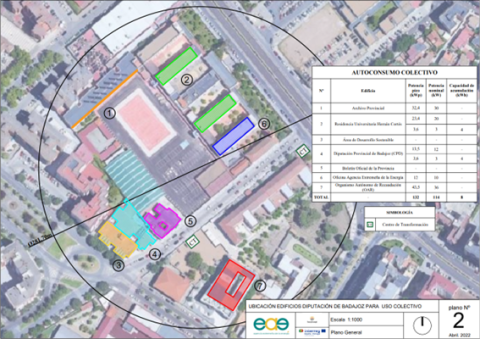
PV Self-Consumption system with storage and monitoring for efficient distribution across 7 buildings

About this good practice
Within the INNOINVEST project, AGENEX has developed a pilot project in Badajoz that focuses on "Energy Shared Self-Consumption with Storage" Co-financed by the European Union's Interreg Spain-Portugal Program (POCTEP), this initiative addresses the challenge of optimizing the use of the renewable energy produced and its storage across multiple public buildings. A 132 kWp solar field, installed together with lithium-ion batteries, enables energy sharing among 7 nearby buildings:
• Hernán Cortés University Residence: 27 kWp.
• Provincial Archive: 32.4 kWp (building’s façade).
• Headquarters of the Rural Development and Sustainability Area.
• Data Processing Centre: 17.1 kWp.
• Extremadura’s Studies Centre.
• Office of the regional tax collection agency (OAR): 43.5 kWp.
• AGENEX: 12 kWp.
This installation uses the local grid within a 1 km radius, enhancing efficiency and reducing costs. Additionally, an External Thermal Insulation System (ETICS) was applied to improve the building's thermal performance in the Provincial Archives. The project encourages research on optimizing rooftop spaces and explores alternative options when rooftops aren't usable. It aims to create a joint management platform for all participating buildings. Key stakeholders include AGENEX, the Provincial Council of Badajoz, and local public institutions. These institutions and the local community, enjoy the reduction in energy expenses and increased sustainability.
Resources needed
The project budget was €162,733.98. It covered PV installations for three buildings (University Residence, Provincial Archive, Data Processing Center) and the ETICS system. The other buildings had existing PV installations. A joint monitoring system, costing €6,157.03, unified them into one network.
Evidence of success
This practice is successful due to its innovative approach to energy distribution based on the consumption profiles of the buildings. The Residence has its highest energy consumption in the afternoon, while other administrative buildings consume more energy in the morning. This complementarity allows to optimize the energy consumption based on the production. This shared scheme of energy self-generation was designed to achieve savings of up to 30% on the annual electricity consumption.
Potential for learning or transfer
This practice is potentially interesting for other regions due to its innovative approach towards shared energy self-consumption, which optimizes renewable energy distribution based on varying consumption profiles of nearby buildings. The key success factors include the ability to adapt the system to different consumption patterns within a community, resulting in significant cost savings and energy efficiency. The prototype's design, which targets up to 30% annual electricity savings, showcases a scalable model for other regions aiming to enhance sustainability.
Furthermore, the project’s successful implementation within a 1 km radius demonstrates that similar initiatives can be transferred to regions in which the grid allows such a practice. A successful transfer requires local grid compatibility, community stakeholder cooperation, and an understanding of the specific energy needs and consumption patterns of the buildings involved.
Further information
Good practice owner
You can contact the good practice owner below for more detailed information.


